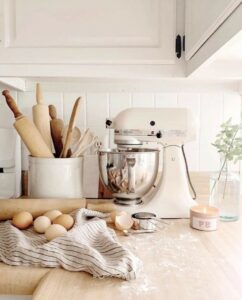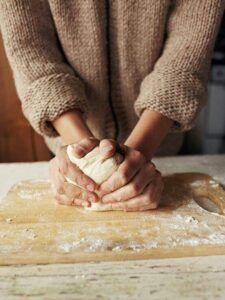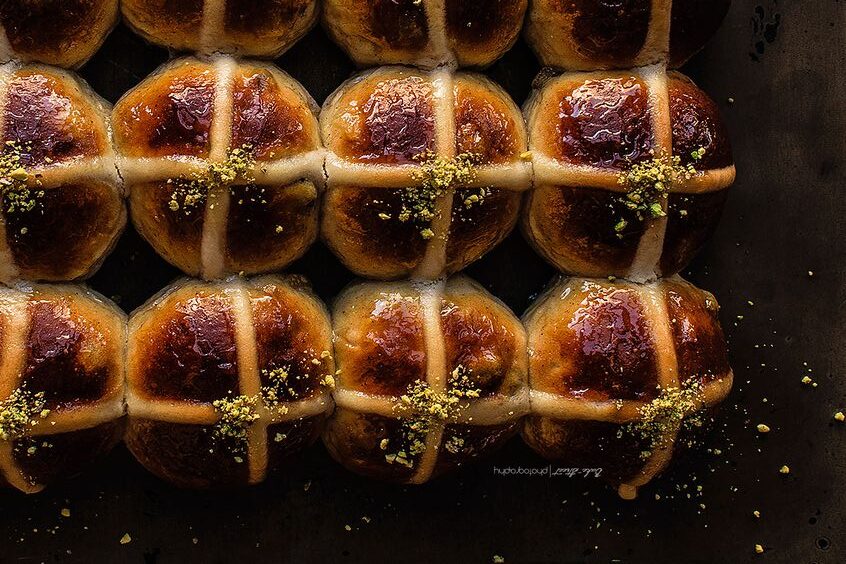Who doesn’t love Hot Cross Buns at Easter?!
Hot Cross Buns, those delightful, spiced treats adorned with a symbolic cross, hold a cherished place in Easter celebrations around the globe. But have you ever wondered where the tradition came about and how we now have such a variety of delicious flavours each year?
Originating as yeasted bread buns, generously speckled with raisins or sultanas and fragrant spices, Hot Cross Buns hold a special significance in Christian culture. Traditionally baked and savored on Good Friday, they serve as a reminder of Lent—a period of reflection, fasting, and sacrifice of Christian’s leading up to Easter Sunday. It’s widely believed that the cross adorning the top of each bun symbolises the crucifixion of Jesus Christ.

Illegal Hot Cross Buns
Yet, the journey of Hot Cross Buns through history is not without its twists and turns. During the reign of Queen Elizabeth I, Britons found themselves forbidden from selling these buns before Good Friday. However, resourceful citizens started baking them within the confines of their homes. As time went on, the enforcement of this prohibition proved increasingly challenging, leading to the eventual normalisation of year-round production and consumption of Hot Cross Buns. In contemporary times, the popularity of Hot Cross Buns has soared, with supermarket shelves stocked with them long before Easter arrives. In fact, in some areas, they’ve been spotted as early as Boxing Day and some stores even choosing to sell them year-round — a phenomenon that has sparked both amusement and negative review among consumers.
Evolution of the Hot Cross Bun
The evolution of the simple Hot Cross Bun has witnessed a transformation as variations emerge over the years – from indulgent toffee and zesty orange-cranberry to decadent sticky-date and comforting caramel-apple-cinnamon, these innovative twists on the classic recipe continue to captivate palates worldwide. In Australia, chocolate-filled variations have become a hit, appealing to the sweet tooth of customers who don’t favour the original spiced fruit bun. Additionally, the creation of miniature versions has further fueled the frenzy, offering bite-sized bursts of flavor that are perfect for snacking or sharing.
For those inclined to get crafty in the kitchen this Easter, creating your own batch of Hot Cross Buns is a great afternoon activity to try on the long-weekend. Hot Cross Buns are relatively easy to make! What could be better than eating one fresh from the oven? Try our recipe below and impress your family and friends this Easter.
Hot Cross Buns Recipe
INGREDIENTS
- 4 cups all-purpose flour
- 1/4 cup granulated sugar
- 1 teaspoon salt
- 1 packet (2 1/4 teaspoons) active dry yeast
- 1 teaspoon ground cinnamon
- 1/4 teaspoon ground nutmeg
- 1/4 teaspoon ground cloves
- 1 1/4 cups warm milk (about 110°F or 45°C)
- 1/4 cup unsalted butter, melted
- 1 large egg
- 3/4 cup raisins or sultanas
For the cross:
- 1/2 cup all-purpose flour
- 1/4 cup water
For the glaze:
- 1/4 cup apricot jam or marmalade
- 1 tablespoon water

METHOD
- In a large mixing bowl, combine 4 cups of flour, sugar, salt, yeast, cinnamon, nutmeg, and cloves.
- In a separate bowl, whisk together the warm milk, melted butter, and egg until well combined.
- Gradually add the wet ingredients to the dry ingredients, stirring until a dough forms.
- Turn the dough out onto a lightly floured surface and knead for about 5-7 minutes, or until the dough is smooth and elastic.
- Place the dough in a greased bowl, cover with a clean kitchen towel, and let it rise in a warm, draft-free place for about 1 hour, or until doubled in size.
- Once the dough has risen, punch it down and knead in the raisins or sultanas until evenly distributed.
- Divide the dough into 12 equal portions and shape each portion into a ball. Place the balls of dough on a greased baking sheet, spacing them a few inches apart.
- Cover the baking sheet with a clean kitchen towel and let the dough rise for another 30-45 minutes, or until puffy.
- Preheat your oven to 375°F (190°C).
- In a small bowl, mix together 1/2 cup of flour and 1/4 cup of water to form a thick paste. Transfer the paste to a piping bag or a plastic bag with the corner snipped off.
- Pipe a cross shape onto the top of each bun.
- Bake the buns in the preheated oven for 15-18 minutes, or until they are golden brown and sound hollow when tapped on the bottom.
- While the buns are baking, prepare the glaze by heating the apricot jam or marmalade with 1 tablespoon of water in a small saucepan over low heat until melted and smooth.
- Once the buns are done baking, brush them with the glaze while they are still warm.
- Allow the buns to cool slightly before serving.
Serve and enjoy!
Enjoy your homemade hot cross buns as a delicious Easter treat or any time of year!
Easter at The Westport Club
Check out what’s happening at The Westport Club this Easter here.

